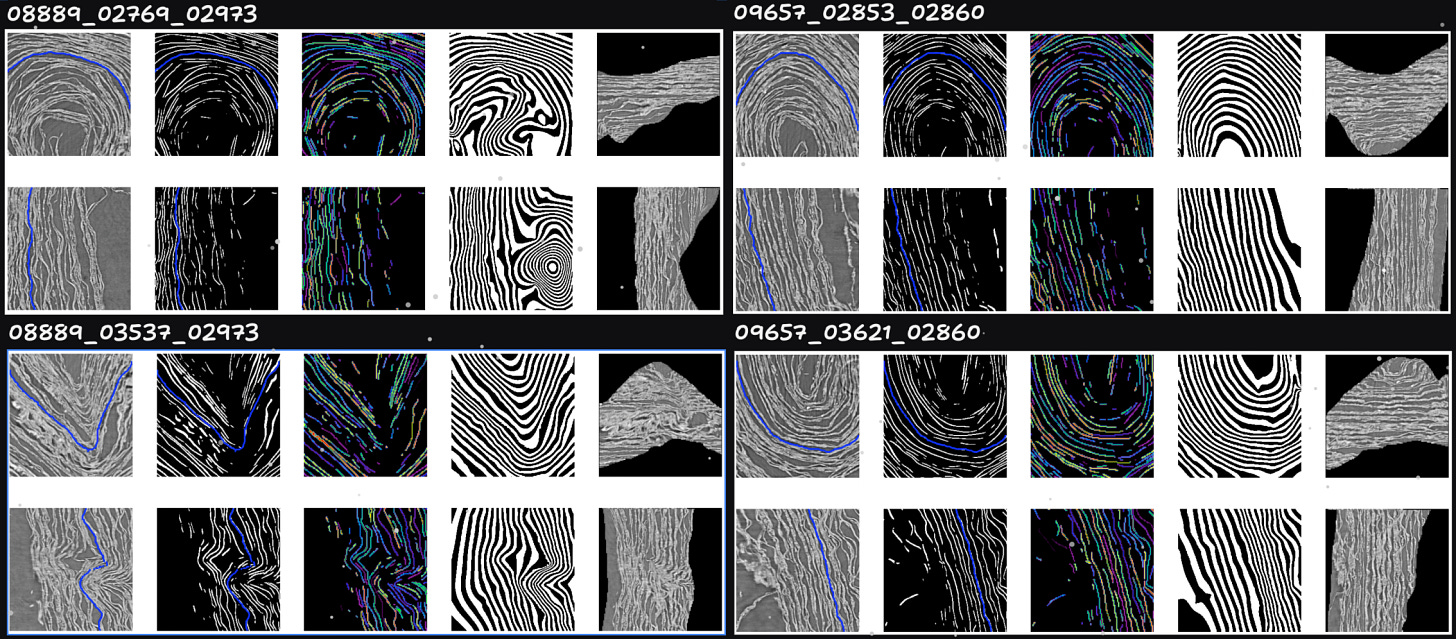Vesuvius Challenge Progress Prizes: December Edition
Ending 2024 with more great advancements
Next up in the 2024 year-end prize series, we are honoring the community advancements submitted for December Progress Prizes!
There’s a heavy focus right now on dialing up the data quality: more and better ink labels, more and better segmentation inputs, refining existing versions of each, better model architectures for segmentation tasks, and so on. This inexorable march forward is illuminating an increasingly clear path towards automated virtual unwrapping. Much remains to do, but the obstacles are going down in size and number all the time…
[potential spoilers] Some submissions for December prizes overlapped heavily with First Automated Segmentation Prize submissions, so, you know. Maybe you’ll hear more about those soon!
For now: these fantastic December contributions!
3 x $2,500 (Sestertius)
Tim Skinner / @Tim S, Lachlan Parker and John Skinner trained a volumetric segmentation model using the team/community generated instance annotation cubes that is capable of some impressive inference outputs. We’re excited to see this addition to our growing family of segmentation models!
Nicola Bodill / @polytrope has contributed a body of ink labels across our scroll datasets! These have been used successfully by other community members for training ink detection models- check out in particular the PHerc. 172 (Scroll 5) labels. This tedious annotation is crucial for improving ink detection!
James Darby / @james darby developed a fork of Khartes (documentation w/ instructional videos) that allows one to interactively refine existing segmentation meshes. This can be used to fix up segmentations as a final product, or to improve them before using them as machine learning inputs. For both use cases, we are excited to see interactive segmentation improvement tooling!
6 x $1,000 (Papyrus)
Johannes Rudolph / @jrudolph developed vesuvius-render, a self-contained CPU-based alternative to vc_render and scroll-renderer.
Yao Hsiao / @Yao Hsiao and Dalufishe / @Dalufish continued work on their electric potential field-based scroll flattening approach, also adding a couple of command line tools for using it!
Chuck / @khartes_chuck added overlay capabilities to Khartes! This is a great way to visualize various data formats (largely segmentation volumes) overlaid on the raw scroll data - check it out using your datasets!
Hendrik Schilling / @waldkauz significantly improved inference times for ink detection, and added some command line settings for tuning the output image quality!
Forrest McDonald / @verditelabs shared a set of segmentation techniques, data, and visualizations, based largely on supervoxels (a 3D extension of superpixels) and on merging them together into “chords” that span the entire scroll height.
William Stevens / @Will Stevens added to a growing set of segmentation tools, this time with particle-based surface flattening and interpolation, as well as simulated annealing for patch assembly. As always with Will’s work, check out the excellent write-up!
2024 has been an incredible year for communal progress on this great technical challenge - and we haven’t covered it all quite yet. Don’t touch that dial!











Slow but steady progress wins in the end! Congratulations to all the hard-working researchers moving this project forward!
Wow!